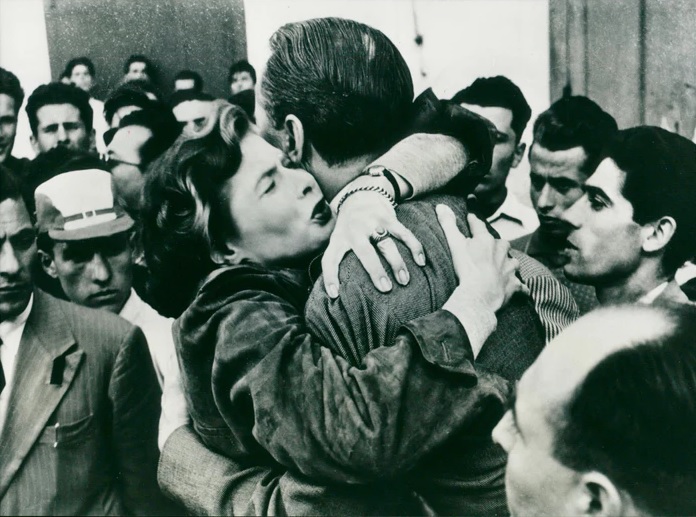Malone presents a much more favorable look on Bergman’s career overall in her previously cited book, Girls on Film. Malone’s regard of Bergman reminds me of my own earliest encounters with the actress and with Journey to Italy specifically. I had long been a fan of Casablanca, and the lead actress had struck me as particularly magnetic, though the more times I watched the film, the more frustrated I felt at how Ilsa (and Bergman as an actor) seemed pushed around by the men who controlled her life, leaving no room for this charismatic star to exercise the full breadth of her talents.
Years later, I had taken a second job at a small arthouse theatre, where I could read books in the old-fashioned box office while waiting to sell tickets and, for free, watch as many indie and foreign films as I could fit into my schedule. (My first job was in an art museum, which perhaps explains my bias in favor of the museum scenes of both Journeys.) One night, we had a special guest, director Terrence Malick (Days of Heaven, Badlands). Most of our guests came to do Q&As paired with their own film’s screening, but Malick wanted to share one of his favorite movies with us instead. He picked Rossellini’s Journey to Italy.
Unlike Mr. Spoto, I was mesmerized. I thought the neorealist style both subdued Bergman’s more dramatic approach to acting while also allowing her to pop and rail against her backdrop—appropriate for the theme of a woman confronting the harsh realities of her failing marriage. Rossellini’s camera seemed fixated on picking up every twinge of psychological nuance that graced her face. This was the type of movie I’d been waiting to see Bergman in.
Heine “cannot leave unmentioned the collection of portraits of beautiful Genoese women, exhibited in the Palace Durazzo,” and I cannot leave unmentioned the reasons why, contrary to the critics, the scenes of Ingrid Bergman meandering through a museum, catacombs, lava fields, and the ruins of Pompeii, should be regarded as some of the most thrilling, fabulously whimsical, brooding scenes ever captured on film. Thank goodness for the French New Wave’s ability to appreciate this picture. For both Heine and Rossellini, these museums open up the most essential (and sometimes funny) feelings about art, sex, and death. Here’s a rather dramatic explanation from Heine of how those things are connected, as he gazes at the portraits of women long deceased, musing on how even their likeness will someday decay:
But sadder far than this idea of an endless dying, and of a desolate yawning annihilation, is the thought that we do not even perish as originals, but as copies of long-vanished mortals who were spiritually and bodily like us, and that, after us, men will again be born, who will in turn see, and feel, and think like us, and be again in turn annihilated by Death.
Heine offers words for Bergman, who, often mute, stumbles aimlessly, furiously, anxiously, determinedly through these spaces of Neapolitan pride. Eerie music trills as if it were an incantation to magically resurrect the dead for Katherine’s visits. Heine’s wit might help some of those critics, the ones who found Rossellini’s Journey humorless, laugh a little. An elderly man gives Katherine a tour of the museum and says of one sculpture: “This is the Venus I like most … She is more mature. Don’t you agree, lady?” Katherine’s response: “Perhaps, I wouldn’t know.” The sultry-yet-mature statue has no arms or head.
On another tour, a guide holds Katherine’s wrists in the holes in the rocks, spreading her arms like a crucifixion; the guide says this is how the ancients would have tied up “a beautiful woman like you.” Kinky stuff. Katherine’s conclusion after one of her tours is that “To think that those men lived thousands of years ago, and you feel that they are just like the men today.”
And to top it off with another weird coincidence, Heine’s museum visit haunts him because he thinks he recognizes himself and the dead Maria (an old lover) in the centuries-old portraits. During Katherine’s museum tour, a guide notes that one ancient statue “looks just like my daughter Marianna.” Both recognize loved ones in likenesses where they were impossible to exist. Perhaps what I’m interested in is not so much adaptation but likeness. A resemblance that at once fits into the cycle of Heine’s “endless dying” and by doing so defies time itself thus allowing us to find ourselves and converse with those asking similar questions across the centuries and through the veil.
As you may have noticed, Journey to Italy has a variety of names. Viaggio in Italia in Italian, it has been translated to Voyage in Italy, The Strangers, The Lonely Woman, and one contemporaneous advertisement seems to refer to it as The Greatest Love—gag! (I’m not sure what other movie the ad could be for.) Heine’s Journey is part of a collection that literally translates to “Pictures,” and “journey” could also be translated as “trip.” So really they are not two journeys to Italy at all. While scholarship on Joyce and Rossellini exists, another story is that Rossellini wanted to adapt the French novel Duo by Colette (1934) but could not get the rights. So he tweaked the tale. A couple’s trip to Southern France became a trek through southern Italy, the settings made interchangeable even though the iconic cinematography of Journey to Italy develops the setting as much as the characters.
Wherever we went, I hope you enjoyed the tours. Thank you for joining me on two journeys to Italy. Or was it three, four? Maybe we did not go anywhere at all.
